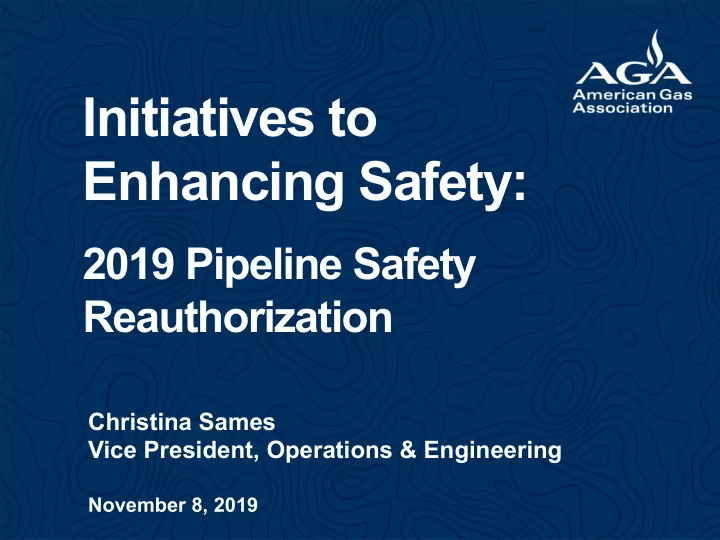

Initiatives to Enhancing Safety: 2019 Pipeline Safety Reauthorization Christina Sames Vice President, Operations & Engineering November 8, 2019
Senate T&I E&C Legislation Key Themes Within Proposed ASVs/ ê RCVs Topics related to distribution Over-pressure ê ê Protection DIMP ê ê Distribution Operations ê ê Records PSMS ê NPMS ê ê Operator ê ê ê Qualifications Emergency ê ê Response Workforce Regulators ê ê ê Development Updates to ê ê Regulations Civil Penalties ê ê Process Cost Benefit ê ê Analysis Criminal ê ê 2 Penalties
Over-Pressure Protection (E&C, Senate) • Require back up protection capable of shutting off, relieving, or controlling release of natural gas • O&M plans to include procedures for over pressurization and MOC • MOC: Applied to significant technology, equipment, procedural, organization change; Requires qualified personnel to review & certify construction plans are accurate, complete, correct 3
Over-Pressure Protection cont. (E&C, Senate) Senate: Within 1 year, PHMSA to require distribution operators assess & upgrade as appropriate each district regulator station • Minimize risk of pressure exceedance caused by common mode of failure • Regulators must have secondary/back up pressure relieving device or other over-pressure protection technology in place • Regulator and monitor configuration must eliminate common mode of failure and shut off or relieve gas • Qualified personnel to monitor pressures of low pressure distribution systems during construction 4
Distribution Integrity Management Program (DIMP) Plans (E&C, Senate) • Evaluate risk of CI + low pressure systems. E&C includes bare steel • Consider factors other than past AOCs • Avoid ranking risk = 0 unless supported by eng. analysis or operational knowledge • PHMSA to audit states to • Ensure sufficient review of DIMP, ER, O&M manuals • Ensure sufficient inspectors • PHMSA or state to review DIMP, ER & O&M Manual at least every 5 yrs; record results 5
Distribution Records (E&C, Senate) • Identify and manage traceable, reliable & complete records that are critical to ensure proper pressure control . E&C: Adds “up to date” • Records to be accessible to all personnel responsible for performing or overseeing - • S: Relevant construction or engineering work • E&C: Any activity that that the potential to cause hazardous over pressurization • S: Other records needed for risk analysis to be collected opportunistically • Records to be submitted or made available to PHMSA/State 6
Operator Qualifications (E&C,Senate) • Requires qualified individual to monitor gas pressure and have capability to promptly shut down flow of gas or otherwise prevent/control over pressurization at a district regulator station • S: During any construction project that has potential to cause hazardous over pressurization • E&C: During any activity that has the potential to cause hazardous over pressurization • Does not apply systems that have a monitoring system & capability for remote/automatic shutoff 7
Emergency Response Plans (E&C, Senate) • Quickly establish communications with 1st responders, public officials, and the public when unintended release of gas that results in: • Fire • Explosion • Fatality • Shutdown of gas to significant # of customers • Develop voluntary opt-in system to allow rapid communication to customers 8
Additional Provisions: Senate • Encourages self disclosure & correction of violations, or actions to correct violation, prior to discovery (this is in line with PSMS) • PSMS: • Report on the # of distribution operators that have implemented and progress made (Note: AGA’s Board has already adopted) • PHMSA/States to promote/assess PSMS frameworks and encourages self disclosure 9
Additional Provisions: House E&C • Community Right to Know: • Review existing public education program: • Use of 1 call • Hazards associated with unintended release • Physical indication of release • Submit description of program + changes • Liaison with state/local emergency response entities • PHMSA to conduct evaluation to determine if emergency responders have sufficient access to information 10
The American Gas Association, founded in 1918, represents more than 200 local energy companies that deliver clean natural gas throughout the United States. There are more than 74 million residential, commercial and TrueBlueNaturalGas.org industrial natural gas customers in the U.S., AGA_naturalgas of which 95 percent — more than 71 million naturalgas customers — receive their gas from AGA aga_natgas members. Today, natural gas meets more than one-fourth of the United States' energy needs. www.aga.org
Recommend
More recommend